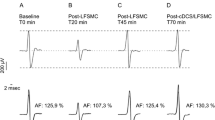Abstract
Paired associative stimulation (PAS), in which peripheral nerve stimuli are followed by transcranial magnetic stimulation (TMS) of the motor cortex, may produce a long lasting change in cortical excitability. At an interstimulus interval slightly shorter than the time needed for the afferent inputs to reach cerebral cortex (10 ms), motor cortex excitability decreases. Indirect data support the hypothesis that PAS at this interval (PAS10) involves LTD like-changes in cortical synapses. The aim of present paper was to investigate more directly PAS10 effects. We recorded corticospinal descending volleys evoked by single pulse TMS before and after PAS10 in two conscious subjects who had a high cervical epidural electrode implanted for pain control. These synchronous volleys provide a measure of cortical synaptic activity. PAS10 significantly reduced the amplitude of later descending waves while the earliest descending wave was not modified. Present results confirm the cortical origin of the effect of PAS10.

Similar content being viewed by others
References
Chen R, Classen J, Gerloff C, Celnik P, Wassermann EM, Hallett M, Cohen LG (1997) Depression of motor cortex excitability by low-frequency transcranial magnetic stimulation. Neurology 48:1398–1403
Chen R, Cros D, Curra A, Di Lazzaro V, Lefaucheur JP, Magistris MR, Mills K, Rosler KM, Triggs WJ, Ugawa Y, Ziemann U (2008) The clinical diagnostic utility of transcranial magnetic stimulation: report of an IFCN committee. Clin Neurophysiol 119:504–532
Classen J, Wolters A, Stefan K, Wycislo M, Sandbrink F, Schmidt A, Kunesch E (2004) Paired associative stimulation. Suppl Clin Neurophysiol 57:563–569
Cooke SF, Bliss TV (2006) Plasticity in the human central nervous system. Brain 129:1659–1673
Di Lazzaro V, Oliviero A, Pilato F, Saturno E, Dileone M, Mazzone P, Insola A, Tonali PA, Rothwell JC (2004) The physiological basis of transcranial motor cortex stimulation in conscious humans. Clin Neurophysiol 115:255–266
Di Lazzaro V, Pilato F, Dileone M, Profice P, Oliviero A, Mazzone P, Insola A, Ranieri F, Meglio M, Tonali PA, Rothwell JC (2008a) The physiological basis of the effects of intermittent theta burst stimulation of the human motor cortex. J Physiol 586:3871–3879
Di Lazzaro V, Pilato F, Dileone M, Profice P, Oliviero A, Mazzone P, Insola A, Ranieri F, Tonali PA, Rothwell JC (2008b) Low-frequency repetitive transcranial magnetic stimulation suppresses specific excitatory circuits in the human motor cortex. J Physiol 586:4481–4487
Di Lazzaro V, Ziemann U, Lemon R (2008c) State of the art: physiology of transcranial motor cortex stimulation. Brain Stimulat 4:345–362
Di Lazzaro V, Dileone M, Pilato F, Profice P, Oliviero A, Mazzone P, Insola A, Capone F, Ranieri F, Tonali PA (2009) Associative motor cortex plasticity: direct evidence in humans. Cereb Cortex
Hess G, Donoghue JP (1999) Facilitation of long-term potentiation in layer II/III horizontal connections of rat motor cortex following layer I stimulation: route of effect and cholinergic contributions. Exp Brain Res 127:279–290
Stefan K, Kunesch E, Cohen LG, Benecke R, Classen J (2000) Induction of plasticity in the human motor cortex by paired associative stimulation. Brain 123(Pt 3):572–584
Thickbroom GW (2007) Transcranial magnetic stimulation and synaptic plasticity: experimental framework and human models. Exp Brain Res 180:583–593
Wolters A, Sandbrink F, Schlottmann A, Kunesch E, Stefan K, Cohen LG, Benecke R, Classen J (2003) A temporally asymmetric Hebbian rule governing plasticity in the human motor cortex. J Neurophysiol 89:2339–2345
Ziemann U (2004) TMS induced plasticity in human cortex. Rev Neurosci 15:253–266
Ziemann U, Rothwell JC (2000) I-waves in motor cortex. J Clin Neurophysiol 17:397–405
Author information
Authors and Affiliations
Corresponding author
Rights and permissions
About this article
Cite this article
Di Lazzaro, V., Dileone, M., Profice, P. et al. LTD-like plasticity induced by paired associative stimulation: direct evidence in humans. Exp Brain Res 194, 661–664 (2009). https://doi.org/10.1007/s00221-009-1774-9
Received:
Accepted:
Published:
Issue Date:
DOI: https://doi.org/10.1007/s00221-009-1774-9




